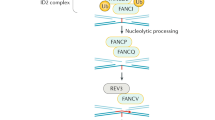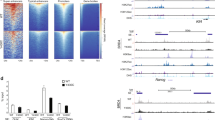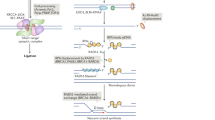Abstract
The autosomal recessive genetic disorder Nijmegen breakage syndrome (NBS) was first described in 1981 in patients living in Nijmegen, Holland. NBS patients display a characteristic facial appearance, microcephaly and a range of symptoms including immunodeficiency, increased cancer risk and growth retardation. In addition, NBS patient cells were found to have elevated levels of chromosomal damage and to be sensitive to ionizing irradiation (IR). This radiosensitivity had fatal consequences in some undiagnosed patients. The most dangerous DNA lesion caused by IR is considered to be the double-strand break (DSB) and indeed, NBS patient cells are sensitive to all mutagens that produce DSBs directly or indirectly. We discuss here our current understanding of how a deficiency in DSB repair manifests as the particular symptom complex of NBS.
This is a preview of subscription content, access via your institution
Access options
Subscribe to this journal
Receive 50 print issues and online access
$259.00 per year
only $5.18 per issue
Buy this article
- Purchase on Springer Link
- Instant access to full article PDF
Prices may be subject to local taxes which are calculated during checkout


Similar content being viewed by others
References
Buslov KG, Iyevleva AG, Chekmariova EV, Suspitsin EN, Togo AV, Kuligina E et al. (2005). NBS1 657del5 mutation may contribute only to a limited fraction of breast cancer cases in Russia. Int J Cancer 114: 585–589.
Carlomagno F, Chang-Claude J, Dunning AM, Ponder BA . (1999). Determination of the frequency of the common 657Del5 Nijmegen breakage syndrome mutation in the German population: no association with risk of breast cancer. Genes Chromosomes Cancer 25: 393–395.
Carney JP, Maser RS, Olivares H, Davis EM, Le Beau M, Yates III JR et al. (1998). The hMre11/hRad50 protein complex and Nijmegen breakage syndrome: linkage of double-strand break repair to the cellular DNA damage response. Cell 93: 477–486.
Chen YC, Su YN, Chou PC, Chiang WC, Chang MC, Wang LS et al. (2005). Overexpression of NBS1 contributes to transformation through the activation of phosphatidylinositol 3-kinase/Akt. J Biol Chem 280: 32505–32511.
Cherry SM, Adelman CA, Theunissen JW, Hassold TJ, Hunt PA, Petrini JH . (2007). The Mre11 complex influences DNA repair, synapsis, and crossing over in murine meiosis. Curr Biol 17: 373–378.
Chrzanowska KH, Piekutowska-Abramczuk D, Popowska E, Gladkowska-Dura M, Maldyk J, Syczewska M et al. (2006). Carrier frequency of mutation 657del5 in the NBS1 gene in a population of Polish pediatric patients with sporadic lymphoid malignancies. Int J Cancer 118: 1269–1274.
Cybulski C, Gorski B, Debniak T, Gliniewicz B, Mierzejewski M, Masojc B et al. (2004). NBS1 is a prostate cancer susceptibility gene. Cancer Res 64: 1215–1219.
Debniak T, Gorski B, Cybulski C, Jakubowska A, Kurzawski G, Lener M et al. (2003). Germline 657del5 mutation in the NBS1 gene in patients with malignant melanoma of the skin. Melanoma Res 13: 365–370.
Demuth I, Frappart PO, Hildebrand G, Melchers A, Lobitz S, Stockl L et al. (2004). An inducible null mutant murine model of Nijmegen breakage syndrome proves the essential function of NBS1 in chromosomal stability and cell viability. Hum Mol Genet 13: 2385–2397.
Difilippantonio S, Celeste A, Fernandez-Capetillo O, Chen HT, Reina San Martin B, Van Laethem F et al. (2005). Role of Nbs1 in the activation of the Atm kinase revealed in humanized mouse models. Nat Cell Biol 7: 675–685.
Difilippantonio S, Celeste A, Kruhlak MJ, Lee Y, Difilippantonio MJ, Feigenbaum L et al. (2007). Distinct domains in Nbs1 regulate irradiation-induced checkpoints and apoptosis. J Exp Med 204: 1003–1011.
Dumon-Jones V, Frappart PO, Tong WM, Sajithlal G, Hulla W, Schmid G et al. (2003). Nbn heterozygosity renders mice susceptible to tumor formation and ionizing radiation-induced tumorigenesis. Cancer Res 63: 7263–7269.
Frappart PO, Tong WM, Demuth I, Radovanovic I, Herceg Z, Aguzzi A et al. (2005). An essential function for NBS1 in the prevention of ataxia and cerebellar defects. Nat Med 11: 538–544.
Gatei M, Young D, Cerosaletti KM, Desai-Mehta A, Spring K, Kozlov S et al. (2000). ATM-dependent phosphorylation of nibrin in response to radiation exposure. Nat Genet 25: 115–119.
Gorski B, Debniak T, Masojc B, Mierzejewski M, Medrek K, Cybulski C et al. (2003). Germline 657del5 mutation in the NBS1 gene in breast cancer patients. Int J Cancer 106: 379–381.
Kang J, Bronson RT, Xu Y . (2002). Targeted disruption of NBS1 reveals its roles in mouse development and DNA repair. EMBO J 21: 1447–1455.
Kracker S, Bergmann Y, Demuth I, Frappart PO, Hildebrand G, Christine R et al. (2005). Nibrin functions in Ig class-switch recombination. Proc Natl Acad Sci USA 102: 1584–1589.
Krüger L, Demuth I, Neitzel H, Varon R, Sperling K, Chrzanowska KH et al. (2007). Cancer incidence in Nijmegen breakage syndrome is modulated by the amount of a variant NBS protein. Carcinogenesis 28: 107–111.
Lee JH, Paull TT . (2005). ATM activation by DNA double-strand breaks through the Mre11–Rad50–Nbs1 complex. Science 308: 551–554.
Lian G, Sheen V . (2006). Cerebral developmental disorders. Curr Opin Pediatr 18: 614–620.
Lim DS, Kim ST, Xu B, Maser RS, Lin J, Petrini JH et al. (2000). ATM phosphorylates p95/nbs1 in an S-phase checkpoint pathway. Nature 404: 613–617.
Maser RS, Zinkel R, Petrini JH . (2001). An alternative mode of translation permits production of a variant NBS1 protein from the common Nijmegen breakage syndrome allele. Nat Genet 27: 417–421.
Matsuura S, Tauchi H, Nakamura A, Kondo N, Sakamoto S, Endo S et al. (1998). Positional cloning of the gene for Nijmegen breakage syndrome. Nat Genet 19: 179–181.
Meyer P, Stapelmann H, Frank B, Varon R, Burwinkel B, Schmitt C et al. (2007). Molecular genetic analysis of NBS1 in German melanoma patients. Melanoma Res 17: 109–116.
O'Driscoll M, Dobyns WB, van Hagen JM, Jeggo PA . (2007). Cellular and clinical impact of haploinsufficiency for genes involved in ATR signaling. Am J Hum Genet 81: 77–86.
Orii KE, Lee Y, Kondo N, McKinnon PJ . (2006). Selective utilization of nonhomologous end-joining and homologous recombination DNA repair pathways during nervous system development. Proc Natl Acad Sci USA 103: 10017–10022.
Payne SR, Kemp CJ . (2005). Tumor suppressor genetics. Carcinogenesis 26: 2031–2045.
Porcedda P, Turinetto V, Lantelme E, Fontanella E, Chrzanowska K, Ragona R et al. (2006). Impaired elimination of DNA double-strand break-containing lymphocytes in ataxia telangiectasia and Nijmegen breakage syndrome. DNA Repair (Amst) 5: 904–913.
Powers JT, Hong S, Mayhew CN, Rogers PM, Knudsen ES, Johnson DG . (2004). E2F1 uses the ATM signaling pathway to induce p53 and Chk2 phosphorylation and apoptosis. Mol Cancer Res 2: 203–214.
Reina-San-Martin B, Nussenzweig MC, Nussenzweig A, Difilippantonio S . (2005). Genomic instability, endoreduplication, and diminished Ig class-switch recombination in B cells lacking Nbs1. Proc Natl Acad Sci USA 102: 1590–1595.
Resnick IB, Kondratenko I, Pashanov E, Maschan AA, Karachunsky A, Togoev O et al. (2003). 657del5 mutation in the gene for Nijmegen breakage syndrome (NBS1) in a cohort of Russian children with lymphoid tissue malignancies and controls. Am J Med Genet 120A: 174–179.
Rhee JG, Li D, Suntharalingam M, Guo C, O'Malley Jr BW, Carney JP . (2007). Radiosensitization of head/neck squamous cell carcinoma by adenovirus-mediated expression of the Nbs1 protein. Int J Radiat Oncol Biol Phys 67: 273–278.
Santarosa M, Ashworth A . (2004). Haploinsufficiency for tumour suppressor genes: when you don't need to go all the way. Biochim Biophys Acta 1654: 105–122.
Seemanova E . (1990). An increased risk for malignant neoplasms in heterozygotes for a syndrome of microcephaly, normal intelligence, growth retardation, remarkable facies, immunodeficiency and chromosomal instability. Mutat Res 238: 321–324.
Seemanova E, Jarolim P, Seeman P, Varon R, Sperling K . (2006a). Increased risk of malignancies in heterozygotes in families of patients with Nijmegen breakage syndrome. Cas Lek Cesk 145: 138–143.
Seemanová E, Hoch J, Herzogová J, Kawaciuk I, Janda J, Kohoutová M et al. (2006b). Mutations in tumor suppressor gene NBS1 in adult patients with malignancies. Cas Lek Cesk 145: 201–203.
Seemanova E, Koutecký J, Radvanská L, Starý J, Seeman P, Gebertová K et al. (2004). Tumor supressor gene NBS1 among children patients with malignancies. Ces-Slov Pediat 59: 242–245.
Seemanova E, Sperling K, Neitzel H, Varon R, Hadac J, Butova O et al. (2006). Nijmegen breakage syndrome (NBS) with neurological abnormalities and without chromosomal instability. J Med Genet 43: 218–224.
Stanulla M, Stumm M, Dieckvoss BO, Seidemann K, Schemmel V, Muller Brechlin A et al. (2000). No evidence for a major role of heterozygous deletion 657del5 within the NBS1 gene in the pathogenesis of non-Hodgkin's lymphoma of childhood and adolescence. Br J Haematol 109: 117–120.
Steffen J, Maneva G, Poplawska L, Varon R, Mioduszewska O, Sperling K . (2006a). Increased risk of gastrointestinal lymphoma in carriers of the 657del5 NBS1 gene mutation. Int J Cancer 119: 2970–2973.
Steffen J, Nowakowska D, Niwinska A, Czapczak D, Kluska A, Piatkowska M et al. (2006b). Germline mutations 657del5 of the NBS1 gene contribute significantly to the incidence of breast cancer in Central Poland. Int J Cancer 119: 472–475.
Steffen J, Varon R, Mosor M, Maneva G, Maurer M, Stumm M et al. (2004). Increased cancer risk of heterozygotes with NBS1 germline mutations in Poland. Int J Cancer 111: 67–71.
Stiff T, Reis C, Alderton GK, Woodbine L, O'Driscoll M, Jeggo PA . (2005). Nbs1 is required for ATR-dependent phosphorylation events. EMBO J 24: 199–208.
Stracker TH, Morales M, Couto SS, Hussein H, Petrini JH . (2007). The carboxy terminus of NBS1 is required for induction of apoptosis by the MRE11 complex. Nature 447: 218–221.
Taylor GM, O'Brien HP, Greaves MF, Ravetto PF, Eden OB . (2001). Correspondence re: R Varon et al., Mutations in the Nijmegen breakage syndrome gene (NBS1) in childhood acute lymphoblastic leukemia. Cancer Res., 61: 3570–3572, 2001. Cancer Res 63: 6563–6564; author reply 6565.
Urist M, Tanaka T, Poyurovsky MV, Prives C . (2004). p73 induction after DNA damage is regulated by checkpoint kinases Chk1 and Chk2. Genes Dev 18: 3041–3054.
Uziel T, Lerenthal Y, Moyal L, Andegeko Y, Mittelman L, Shiloh Y . (2003). Requirement of the MRN complex for ATM activation by DNA damage. EMBO J 22: 5612–5621.
Varon R, Reis A, Henze G, von Einsiedel HG, Sperling K, Seeger K . (2001). Mutations in the Nijmegen breakage syndrome gene (NBS1) in childhood acute lymphoblastic leukemia (ALL). Cancer Res 61: 3570–3572.
Varon R, Vissinga C, Platzer M, Cerosaletti KM, Chrzanowska KH, Saar K et al. (1998). Nibrin, a novel DNA double-strand break repair protein, is mutated in Nijmegen breakage syndrome. Cell 93: 467–476.
Weemaes CM, Hustinx TW, Scheres JM, van Munster PJ, Bakkeren JA, Taalman RD . (1981). A new chromosomal instability disorder: the Nijmegen breakage syndrome. Acta Paediatr Scand 70: 557–564.
Yeo TC, Xia D, Hassouneh S, Yang XO, Sabath DE, Sperling K et al. (2000). V(D)J rearrangement in Nijmegen breakage syndrome. Mol Immunol 37: 1131–1139.
Yuan Z, Zhang X, Sengupta N, Lane WS, Seto E . (2007). SIRT1 regulates the function of the Nijmegen breakage syndrome protein. Mol Cell 27: 149–162.
Zhang Y, Lim CU, Zhou J, Liber HH . (2007). The effects of NBS1 knockdown by small interfering RNA on the ionizing radiation-induced apoptosis in human lymphoblastoid cells with different p53 status. Toxicol Lett 171: 50–59.
Zhu J, Petersen S, Tessarollo L, Nussenzweig A . (2001). Targeted disruption of the Nijmegen breakage syndrome gene NBS1 leads to early embryonic lethality in mice. Curr Biol 11: 105–109.
Acknowledgements
We thank the Deutsche Forschungsgemeinschaft and the Friedrich-Thyssen-Stiftung for financial support. We regret being unable to cite the excellent work of many authors due to space restrictions.
Author information
Authors and Affiliations
Corresponding author
Rights and permissions
About this article
Cite this article
Demuth, I., Digweed, M. The clinical manifestation of a defective response to DNA double-strand breaks as exemplified by Nijmegen breakage syndrome. Oncogene 26, 7792–7798 (2007). https://doi.org/10.1038/sj.onc.1210876
Published:
Issue Date:
DOI: https://doi.org/10.1038/sj.onc.1210876
Keywords
This article is cited by
-
Chromosomal instability associated with adverse outcome: a case report of patient with Nijmegen breakage syndrome and rapidly developed T-NHL with complex karyotype
Molecular Cytogenetics (2020)
-
Evidence for a pre-malignant cell line in a skin biopsy from a patient with Nijmegen breakage syndrome
Molecular Cytogenetics (2018)
-
DNA damage response and hematological malignancy
International Journal of Hematology (2017)
-
DNA replication stress: from molecular mechanisms to human disease
Chromosoma (2017)
-
Clinicopathological values of NBS1 and DNA damage response genes in epithelial ovarian cancers
Experimental & Molecular Medicine (2015)



